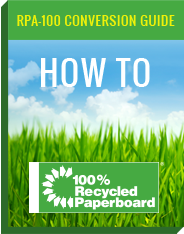The key benefits of 100% Recycled Paperboard
The Environment
North America recycles approximately 3.1 million tons of recovered fiber into CRB every year, with an additional 4.5 million tons of recovered fiber recycled into URB. In addition, the 100% recycled paperboard industry is the primary purchaser of old corrugated containers (OCC). OCC is recovered fiber from retail stores and industrial sources that is converted into 100% recycled paperboard and ultimately into packaging.When the manufacturing processes of CRB is compared to solid bleached sulfate (SBS), and URB is compared to uncoated natural kraft (UNK), the environmental benefit of 100% recycled paperboard becomes clear. The Environmental Defense Fund provides the following information based on the conversion of virgin paperboard to 100% recycled paperboard:
For every ton of virgin paperboard that is converted to CRB/URB, one ton of recovered fiber is kept out of municipal landfills. This, in turn, reduces the amount of methane created in the landfill and further decreases greenhouse gases in the atmosphere.
- Trees are saved for every converted ton, allowing sequestration of carbon dioxide (CO2) in North America. Sequestration is the accumulation and storage of carbon in growing trees.
- Enough energy is saved to heat someone’s home for an entire year. Production of CRB/URB requires 50% less energy than virgin grades of paperboard.
- The amount of air pollution avoided is equivalent to removing 6 six 18-wheeler trucks from the road each year.
- The greenhouse gases that are prevented are equal to removing 54 cars from the road each year.
- The waste water that is not produced each year is the equivalent to the amount of water in 7 seven Olympic-sized swimming pools.
The Most Environmentally Sustainable
Packaging Material
While some producers of virgin paperboard may include a small percentage of recovered fiber in the production of their paperboard, there is no alternative to paperboard made from 100% recovered fiber. There is no other packaging product that is more environmentally sustainable than CRB/URB. The important fact is that 100% recycled fiber paperboard truly is 100% recycled, with no virgin fiber content.
Performance & Strength
CRB is functionally equivalent to virgin grades of paperboard, so there’s no need to increase a paperboard package’s caliper when converting to 100% recycled paperboard. It is functionally equivalent to SBS/CUK in the areas of strength, graphics, cleanliness and overall quality and consistency. Independent studies by Michigan state State University’s, School of Packaging, have shown that CRB can be custom engineered to perform equivalently to SBS/CUK in compression testing – the leading indicator of strength and performance.
A 25-Year Cost Advantage
100% coated and uncoated recycled paperboard (CRB/URB) have enjoyed a cost advantage over virgin grades for more than 20 years. The cost of raw materials is lower; the process uses 50% less energy; and the manufacturing of CRB/URB has undergone continuous improvement leading to increased efficiencies and throughput over the last 25 years.
Our Conversion Guide
CONVERSION FAQ
What is 100% recycled paperboard? How is it made? How does it compare to virgin paper grades? What are the advantages in using it for packaging products?
ADDITIONAL RESOURCES
Here's a curated list of external resources you will find useful if you need more information about a specific aspects of 100% recycled paperboard.
